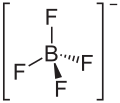| Revision as of 18:59, 6 October 2014 editFivemack (talk | contribs)Extended confirmed users1,511 editsNo edit summary← Previous edit | Revision as of 18:59, 6 October 2014 edit undoFivemack (talk | contribs)Extended confirmed users1,511 editsNo edit summaryNext edit → | ||
| Line 68: | Line 68: | ||
| :8 BF<sub>3</sub> + 6 ] → ] + 6 LiBF<sub>4</sub> | :8 BF<sub>3</sub> + 6 ] → ] + 6 LiBF<sub>4</sub> | ||
| LiBF<sub>4</sub> can also be synthesized from LiF and BF<sub>3</sub> |
LiBF<sub>4</sub> can also be synthesized from LiF and BF<sub>3</sub> in an appropriate solvent (e.g. HF, ], or liquified ]) <ref name="Ullmann" />; the solvent has to be resistant to fluorination by the BF<sub>3</sub>. | ||
| : LiF + BF<sub>3</sub> → LiBF<sub>4</sub> | : LiF + BF<sub>3</sub> → LiBF<sub>4</sub> | ||
Revision as of 18:59, 6 October 2014
| |||
| Names | |||
|---|---|---|---|
| IUPAC name Lithium tetrafluoroborate | |||
| Other names Borate(1-), tetrafluoro-, lithium | |||
| Identifiers | |||
| CAS Number | |||
| 3D model (JSmol) | |||
| ChemSpider | |||
| ECHA InfoCard | 100.034.692 | ||
| PubChem CID | |||
| CompTox Dashboard (EPA) | |||
InChI
| |||
SMILES
| |||
| Properties | |||
| Chemical formula | LiBF4 | ||
| Molar mass | 93.746 g/mol | ||
| Appearance | White/grey crystalline solid | ||
| Odor | odorless | ||
| Density | 0.852 g/cm solid | ||
| Melting point | 296.5 °C | ||
| Boiling point | decomp | ||
| Solubility in water | Very soluble | ||
| Hazards | |||
| Occupational safety and health (OHS/OSH): | |||
| Main hazards | Harmful, causes burns, hygroscopic. | ||
| NFPA 704 (fire diamond) |
 | ||
| Related compounds | |||
| Other anions | Tetrafluoroborate, | ||
| Except where otherwise noted, data are given for materials in their standard state (at 25 °C , 100 kPa).
| |||
Lithium tetrafluoroborate is a chemical compound with the formula LiBF4. It can be dissolved in propylene carbonate, dimethoxyethane, and/or gamma-butyrolactone for use as an electrolyte in Lithium-ion batteries.
Applications
LiBF4 is used as an electrolyte in Lithium-ion batteries. Using LiBF4 instead of the more common LiPF6 salt is advantageous in some applications due to its relative tolerance of temperature extremes and moisture. For example LiBF4 can tolerate a moisture content up to 620 ppm at room temperature whereas LiPF6 readily hydrolyzes into toxic POF3 and HF gases, often destroying the battery's electrode materials. Disadvantages of the electrolyte include a relatively low conductivity and difficulties forming a stable solid electrolyte interface with graphite electrodes.
Because LiBF4 and other alkali-metal salts thermally decompose to evolve boron trifluoride, the salt is commonly used as a convenient source of the chemical at the laboratory scale:
Production
LiBF4 is a byproduct in the industrial synthesis of diborane:
LiBF4 can also be synthesized from LiF and BF3 in an appropriate solvent (e.g. HF, BrF3, or liquified SO2) ; the solvent has to be resistant to fluorination by the BF3.
- LiF + BF3 → LiBF4
References
- GFS-CHEMICALS
- S. Zhang, K. Xu, T. Jow (2003). "Low-temperature performance of Li-ion cells with a LiBF4-based electrolyte" (PDF). Journal of Solid State Electrochemistry. 7 (3): 147–151. doi:10.1007/s10008-002-0300-9. Retrieved 16 February 2014.
{{cite journal}}: CS1 maint: multiple names: authors list (link) - S. S. Zhang;z K. Xu; and T. R. Jow (2002). "Study of LiBF4 as an Electrolyte Salt for a Li-Ion Battery". Journal of The Electrochemical Society. 149 (5): A586 – A590. doi:10.1149/1.1466857. Retrieved 16 February 2014.
{{cite journal}}: CS1 maint: multiple names: authors list (link) - ^ Robert, Brotherton; Joseph, Weber; Clarence, Guibert; and John, Little (2000). "Boron Compounds". Ullmann's Encyclopedia of Industrial Chemistry: pg. 10. doi:10.1002/14356007.a04_309.
{{cite journal}}:|access-date=requires|url=(help);|page=has extra text (help)CS1 maint: multiple names: authors list (link) - Brauer, Georg (1963). Handbook of Preparative Inorganic Chemistry Vol. 1, 2nd Ed. Newyork: Academic Press. p. 773. ISBN 978-0121266011.
This inorganic compound–related article is a stub. You can help Misplaced Pages by expanding it. |

